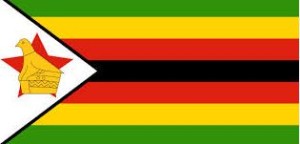Zimbabwe Flag
Zimbabwe flag(pictured) is very distinguishable with unique colours and design. The flag has a total of five colours namely: yellow, white, red, black and green. Each of these colours has a meaning attached to it.
It is clear that the Zimbabwe flag has got same colour as many African countries. This could be due to the history and aspirations of these countries. This is apparent when you look at the meaning of different colours and symbols shown on Zimbabwe flag.
Zimbabwe Flag: colour & meaning
White: The white colour on Zimbabwe Flag stands for peace. The Zimbabwe flag was officially adopted at independence in 1980 when Zimbabwe got its independence from Britain. This came after a protracted war of liberation that stretched close to 2 decades. The struggle pitted Zimbabwe African nationalists against Rhodesian forces.
Red: The colour red is very visible close to the middle line on Zimbabwe flag. It is also on the white triangle. Red symbolises the blood that was shed during the liberation war. Many civilians and combatants lost their lives during the war.
Black: The black colour on the Zimbabwe flag represents the native African people. They make majority of the population which also include other races like people of European and Asian origin.
Green: Green symbolises the natural resources that the country has. Zimbabwe has a wide variety of natural resources including wildlife available in its game reserves and national parks.
Yellow: Zimbabwe has vast mineral resources including gold, diamonds, copper, chrome and many other precious metals. They are represented by yellow on the Zimbabwe flag.
Zimbabwe Bird
The Zimbabwe bird as the name sounds is a national symbol. On the Zimbabwe flag it is superimposed on a five pointed star. This sign is prominent as it is used as a national emblem. It is commonly used on official government communications and properties.
The bird itself is a fish eagle originating Great Zimbabwe Ruins. Great Zimbabwe is an ancient African stone empire that existed between the 11th and 16th century.

